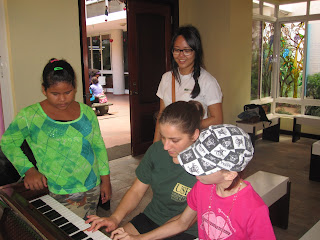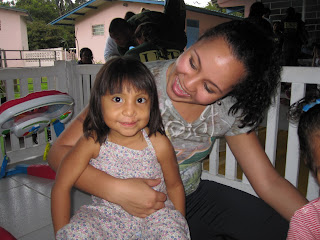Early morning and we were off to our first volunteer
experience in Panama at FANLYC, (Fundacion Amigos de Ninos con Leukemia y
Cancer: Foundation Friends of Children with Leukemia and Cancer). FANLYC is a live-in center for chronically ill cancer patients next to
the children’s hospital, “Hospital del Nino.” We were all welcome with open
arms and given a tour right away. I right away thought “this place is like an
oasis for cancer patients,” it was peaceful and cheerful. I thought it was
wonderful that the patients could have an escape so far away from the
environment of, yet so close to the hospital where they receive their intensive
chemotherapy, radiation, and (or) surgeries. Though we missed their annual
Christmas party and were not able to help in decorating and organizing for it,
the FANLYC staff found some more basic needs that could use our attention. At
first there was not enough work for every large person in our group, but
eventually everyone found their niche and was happy to do his/her part. By late
morning, the lunchroom was spick-and-span, over 100 carrots were peeled and
chopped for lunch, the outdoor area was cleaned, and a couple of the kids were
entertained. Our time at FANLYC really allowed us to work as a group and showed
the impact of teamwork.
Arriving at the rural clinic, Clinica Paraiso, the
differences in the environment between this medical center versus the public
and private hospitals. It was very clear to see that monetary donations are in
dire need at the clinic from the moment we walked in. The ceiling had water
damage and was missing a few tiles, the equipment was (let’s just call it)
vintage, and there was very little space even for the equipment they did have.
While the clinic was not in the best condition, anyone walking in would be able
to tell that a little goes a long way for the staff and the patients. The
condition of the clinic was rough, but it wasn’t until I saw the ER that I
realized how rough things really were. The staff, despite the condition of the
ER, was proud to tell us that Paraiso was home to one of the five ambulances
for the sixteen rural clinics in the region, and that even though their
ambulance was old, they were
grateful to have one. The attitude of the staff at the clinic made me
realize that even though they may not be getting the best, they are definitely getting the best of the physicians
and medical team. The check from the 2010 Panama class was presented to the
clinic and right away designated for fixing the leak in the ceiling and repair
of the water damage it had already caused. This was very exciting, in that the
money was already going to be put to use and for something we all knew the
clinic needed.
I HOPE THE 2012 PANAMA EXPERIENCE CLASS WILL CONSIDER
DONATING TO THE PARAISO COMMUNITY HEALTH CENTER!
After a delicious lunch, we arrived at Nutre Hogar, a
temporary home for the sick and destitute children of Panama with a focus on
malnutrition. While we were there to present the money we have raised over the
last four months, we were more excited for the hour we were scheduled to spend
with the children. After a quick tour, we were asked to assist with taking the
children out for playtime. The babies had to be left inside because they were
more dependent and at a higher risk of infection. Most of the students found a
child to take outside. I have to admit, I was worried I would be left without
interaction. I was surprised and happy to see everyone trying to spend time,
not just with the child they had initially, but with all of the children. It was
so wonderful to be a part of this and see the compassion and willingness to
help of our entire group once again J
We quickly became attached to the children after playing with and feeding them,
some of us attached to a particular child, but just as quickly we had to say
goodbye and prepare for the rest of our day.
I became attached to a little one
named Cumila. At first she would not smile, talk, or interact much, but once we
found something that she did like (she thought it was funny to play with fallen
strands of hair) she spent the rest of the time being the sweetest little girl.
I couldn’t get over the change I had seen in her in just an hour. Leaving her was really hard for me
though, I had finally gotten her to laugh and play and just as easily made her
cry when it was time to go. I wish her the best as I do to Nutre Hogar and hope
I will see her again one day!
Dressed up and ready to go, the group, minus Lisa who was
unfortunately not feeling well, headed to Tinajas for dinner. We had an
incredible meal in a beautiful ambiance and to top it all of we were the
audience of an incredible performance representing traditional Panamanian dance
and culture. The smiles would not come off the performers faces, in contrast to
the Embera performers who seemed to be bored with the task of performing for
tourists, though they are proud of their heritage and culture. I am not sure if
it had to do with the amount of money being paid to the dancers performing in
an upscale restaurant versus the Embera who work to feed the entire tribe or
the difference in the attitudes of their audiences that affected the
performances, but the differences were noticeable. The performance at Tinajas,
however, really did make the evening spectacular, even though we all really
missed Lisa.Early morning and we were off to our first volunteer
experience in Panama at FANLYC, (Fundacion Amigos de Ninos con Leukemia y
Cancer: Foundation Friends of Children with Leukemia and Cancer). FANLYC is a live-in center for chronically ill cancer patients next to
the children’s hospital, “Hospital del Nino.” We were all welcome with open
arms and given a tour right away. I right away thought “this place is like an
oasis for cancer patients,” it was peaceful and cheerful. I thought it was
wonderful that the patients could have an escape so far away from the
environment of, yet so close to the hospital where they receive their intensive
chemotherapy, radiation, and (or) surgeries. Though we missed their annual
Christmas party and were not able to help in decorating and organizing for it,
the FANLYC staff found some more basic needs that could use our attention. At
first there was not enough work for every large person in our group, but
eventually everyone found their niche and was happy to do his/her part. By late
morning, the lunchroom was spick-and-span, over 100 carrots were peeled and
chopped for lunch, the outdoor area was cleaned, and a couple of the kids were
entertained. Our time at FANLYC really allowed us to work as a group and showed
the impact of teamwork.


































No comments:
Post a Comment